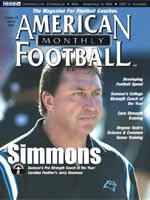AMERICAN FOOTBALL MONTHLY THE #1 RESOURCE FOR FOOTBALL COACHES
|
|
Article Categories
|
Football SpeedImprove variables in your drills for better reaction time on the field. by: Danny Arnold© More from this issueIf youíre the fastest team on the field, great! If not,
you have a problem. So letís prevent that from happening.
Sound easier said than done? Well, itís easier than you think.
In most cases, when a linebacker gets beat by a running back around the corner,
we simply think the running back is just faster. But in more cases than not,
the running back didnít get around the corner because he had more speed;
it was because the linebacker didnít have football speed.
What do I mean when I say speed or football speed?
Although most teams measure and train players for speed (40 yard sprint), most
games are decided by football speed. Teams with more football speed, more often
than not, win the games. Having football speed or speed are two dif....The full article can only be seen by subscribers.
Subscribe today!

|
|
|
NOT A SUBSCRIBER?
Subscribe
now to start receiving our monthly magazine PLUS get INSTANT
unlimited access to over 4000 pages of 100 percent football coaching
information, ONLY available at AmericanFootballMonthly.com!
|
|
|
HOME
|
MAGAZINE
|
SUBSCRIBE
|
ONLINE COLUMNISTS
|
COACHING VIDEOS
|
Copyright 2025, AmericanFootballMonthly.com
All Rights Reserved






